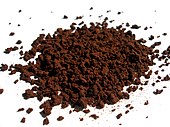Instant coffee
Soluble coffee , quick coffee or instant coffee (from English instant coffee ) is dried coffee extract . Pouring hot water on this powder immediately creates a coffee drink . According to Directive 1999/4 / EC of the European Parliament and of the Council of February 22, 1999 on coffee and chicory extracts and the German Coffee Ordinance, only roasted coffee beans using water as an extraction agent are permitted for production . This also applies to instant varieties of chicory or country coffee. Liquid coffee extract can also contain up to 12% sugar, liquid chicory extract up to 35%.
Compared to regular coffee beans, instant coffee contains about half the caffeine .
history
Instant or soluble coffee was first invented in 1881 by the Frenchman Alphonse Allais and registered as patent no.141 520. In 1890 it was also patented by New Zealander David Strang from Invercargill and sold under the trade name Strang's Coffee . Often the invention is mistakenly attributed to Satori Kato , a Japanese scientist who worked in Chicago in 1901 . The Swiss company Nestlé laid the foundation for industrial production in 1938 with its Nescafé product .
Manufacturing
First, the coffee beans are cleaned, stripped of foreign bodies, weighed and temporarily stored in silos, followed by roasting and grinding. Depending on the desired taste and aroma of a coffee blend, coffees of different types ( Arabica or Robusta ) and origin and quality are coordinated. Depending on the recipe, this mixture can either be done before roasting or it can be done after each variety or provenance has been roasted individually. The soluble components of the coffee are extracted from the ground coffee, the grind of which (approx. 2 mm) is not comparable with that which is used in commercially available coffee machines. Such an extraction system works with water temperatures of up to 200 ° C, for which a pressure of up to 20 bar is necessary so that the water does not evaporate. The ground coffee is in so-called percolators , through which the hot water flows and thereby dissolves the soluble components of the coffee. The coffee extract obtained in this way is concentrated in an evaporation system and then dried. The productivity of such an extraction system is about ten times that of a normal household coffee machine.
The coffee grounds remaining after the extraction are usually burned in a steam boiler to recover energy for the extraction process.
Spray drying
In spray drying , the coffee extract is pumped at high pressure into atomizer nozzles in the upper part of a so-called spray tower. Hot dry air flows in from below. The water in the extract evaporates as it falls through the spray dryer, and the spray-dried instant product collects in the lower part of the spray tower. Spray drying produces a finely powdered, soluble coffee powder. This is mainly used in soluble cappuccino.
By agglomeration greater can be prepared from the fine powder metastable particles (diameter of a few millimeters) produced soluble coffee.
Freeze drying
During freeze-drying , the coffee extract is first exposed to air or CO 2 (foamed) and cooled to approx. −5 ° C. This product, which is comparable to soft ice cream , is then frozen on a freezer belt down to approx. −50 ° C, then ground in a cold room and sieved. The water, which has solidified into ice, is sublimed in a vacuum dryer . The remaining solid component is the instant coffee.
use
In addition to being used as a hot drink, instant coffee is also used cold in the café frappé . It is also used in analog photography as an ingredient in the Caffenol developer liquid .
taxation
In Germany, soluble coffee is taxed at € 4.78 per kilogram under the Coffee Tax Act.
Web links
Individual evidence
- ↑ Directive 99/4 / EC of the European Parliament and of the Council of February 22, 1999 on coffee and chicory extracts , accessed on November 24, 2017
- ↑ MARKTCHECK checks Nescafé: great coffee? In: swr.de. October 18, 2012, accessed November 24, 2017 .
- ↑ Dominique Bougerie: Honfleur et les honfleurais. Cinq siècles d'histoires. Ed. Marie, 2002, p. 138.
- ^ First Annual Report . In: Patents, Designs and Trade-marks . 1890.




